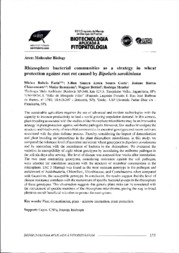Rhizosphere bacterial communities as a strategy in wheat protection against root rot caused by Bipolaris sorokiniana.
Rhizosphere bacterial communities as a strategy in wheat protection against root rot caused by Bipolaris sorokiniana.
Author(s): FARIA, M. R. de; COSTA, L. S. A. S.; CHIARAMONTE, J. B.; ROSSMANN, M.; BETTIOL, W.; MENDES, R.
Summary: The sustainable agriculture requires the use of advanced and modern technologies with the capacity to increase productivity to feed a world growing population demand. In this context, plant breeding associated with the studies of the rhizosphere microbiome may be an innovative strategy in plant protection against soil-borne pathogens. However, few studies investigate the structure and biodiversity of microbial communities in ancestral genotypes and recent cultivars associated with the plant defense process. Thereby, considering the impact of domestication and plant breeding on interactions in the plant rhizosphere microbiome, in this study, we compared the tolerance level of ancestral and recent wheat genotypes to Bipolaris sorokiniana and its correlation with the recruitment of bacteria in the rhizosphere. We evaluated the variation in susceptibility of eight wheat genotypes by inoculating the soilborne pathogen in the soil six days after sowing. The level of disease was assessed four weeks after inoculation. The two most contrasting genotypes, considering resistance against the soil pathogen, were selected for correlation analyzes with the structure of microbial communities in the rhizosphere. IAC 5 Maringá was found as the most resistant genotype to the pathogen and enrichment of Acidobacteria, Chloroflexi, Rhizobiaceae, and Cyanobacteria when compared with Guamirim, the susceptible genotype. In conclusion, the results suggest that the level of disease resistance correlates with the recruitment of specific bacterial groups in the rhizosphere of these genotypes. This observation suggests that genetic plant traits can be associated with the recruitment of specific members of the rhizosphere microbiome, paving the way to breed plants to recruit beneficial microbes to protect the root system.
Publication year: 2018
Types of publication: Abstract in annals or event proceedings
Unit: Embrapa Environment
Observation
Some of Embrapa's publications are published as ePub files. To read them, use or download one of the following free software options to your computer or mobile device. Android: Google Play Books; IOS: iBooks; Windows and Linux: Calibre.
Access other publications
Access the Agricultural Research Database (BDPA) to consult Embrapa's full library collection and records.
Visit Embrapa Bookstore to purchase books and other publications sold by Embrapa.

